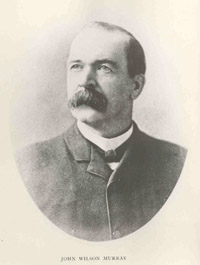
A Brief History of the Ontario Provincial Police
The evolution of the Ontario Provincial Police begins with the First Parliament of Upper Canada on September 17th, 1792, at Niagara-on-the-Lake when provision was made for the formation of a “police system”.
From these humble beginnings, the O.P.P.’s growth has paralleled the development of our province. Initially, policing jurisdictions were limited to districts, townships, and parishes.
In 1877, ten years following Confederation, the “Constables’ Act” extended jurisdiction giving designated police members authorization to act throughout the province.
The first salaried “Provincial Constable” appointed to act as “Detective for the Government of Ontario” was John Wilson Murray.
*****
On October 13, 1909, a provincial Order-in-Council decreed the establishment of the "Ontario Provincial Police Force" - a permanent force of salaried police constables. From its earliest days to today, the strength of the O.P.P. has been its people.
The O.P.P.’s roots can be traced back to the 19th century. John Wilson Murray, the province’s first full-time paid criminal detective, began his 31-year career in 1875. A small staff of government detectives worked for the Attorney General’s office up until 1909. At the time of the O.P.P.’s formation, many of the individuals already working directly for the province as "provincial constables" were subsequently hired by the O.P.P.
The O.P.P.’s first chief of police, Superintendent Joseph E. Rogers, commanded six inspectors and 38 constables. During these early years, many officers worked in one-person detachments, with no radio communication or motor vehicle transportation.
In the early 1920s, the successive appointments of two military men to the position of commissioner helped transform the organization. Badge numbers, military style uniforms, insignia, and protocols all helped define the character of the new and expanding force.
In 1930, motorcycle personnel from the Department of Public Highways joined the O.P.P. motorcycle patrol to police Ontario’s increasingly busy highways.
In 1941, the O.P.P. made a major purchase of marked cruisers - the beginning of an indelible link of cruiser and patrol officer. The war years also saw the formation of volunteer groups who assisted officers with their duties. These were the forebears of today’s O.P.P. Auxiliary Program.
The introduction of a radio system in 1947 (considered at the time to be the largest, most modern police communication system of its kind) heralded a new era in communications.
The 1950s saw an increase in the volume of vehicles on roads, and in 1956, 75 percent of members were busy enforcing the Highway Traffic Act. Shortly thereafter, the O.P.P. began using underwater breathing equipment for the first time and snow vehicles in the north.
A major reorganization of the O.P.P., initiated by Commissioner Eric Silk, characterized the 1960s. What followed was a period of rapid growth through modernization, diversity and training. For example, in 1965, the O.P.P. was the first Canadian police service to commence traffic law enforcement by air.
In 1974, the first women O.P.P. police officers were hired for active duty.
In 1977, the O.P.P. made a major advancement in technology by introducing the first laser for forensic identification.
The early 1980s saw several changes to the police uniform to provide wearers with more comfort, including the introduction of the first protective vests for officers. Computers and a new telecommunication system increased efficiency across the province.
In September 1995, the new General Headquarters in Orillia opened to the public. This marked the first time all O.P.P. services were located under one roof.
In May 1998, Gwen M. Boniface became the 12th commissioner of the O.P.P. and the first woman to hold that rank.
Today, more than 6,000 employees, including more than 5,000 uniform members, provide policing services out of six regions and 93 detachments across the province, using every mode of transportation available.
With its many specialized units, the O.P.P. is recognized as a strong, dynamic and modern organization, equipped to face new challenges of the 21st century.
NOTE:
In 1921, restructuring was undertaken. The title of the commanding officer was changed to Commissioner.
Major General Henry M. Cawthra-Elliot was appointed as the first Commissioner.
Since then, the Force has gone through twelve leadership changes.
Julian Fantino, the current Commissioner, took office in October 2006.
Each Commissioner has made a unique impact on O.P.P. development.
